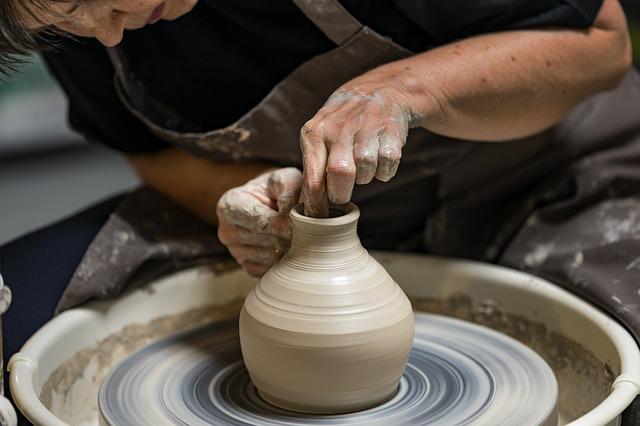An art movement that originated in Britain in the 1850s, reached the height of its popularity at the turn of the 20th century, and its influence continued until World War II. The goal of the movement's participants was to renew the various branches of the arts so that the objects surrounding humans (furniture, interior design, books, etc.) would be both functional and beautiful. The movement's founders denied these values to mass-produced industrial products.
Contents
Programmatically anti-industrial Arts & Crafts theorists glorified craftsmanship and individual, handmade work. They emphasized the high quality of craft products and the ethical and social superiority of craftsmanship over factory production. The inspiration for the creators of Arts & Crafts was the British writer and aesthete John Ruskin. In his writings, he drew attention to the dangers of separating the creative act (design) from the physical labour itself.
The effect of the Industrial Revolution was to reduce workers almost to the role of a machine component. The consequence of industrialization was the degeneration of workers and the disappearance of the aesthetic sense. "It is necessary to create useful and functional art, which at the same time would not lose its aesthetic values," - urged writer and art critic John Ruskin, a great advocate of a return to the craft practices of the Gothic era, which he believed was the "fairest" style in art.
According to Ruskin, the monotonous performance of repetitive tasks, the lack of influence on the final effect, poor working conditions, and the disappearance of individuality were inseparable from work in factories. One of the first artists to incorporate Ruskin's ideas was Augustus W.N. Pugin, designer of the British Parliament building.
Beginnings of the artistic craft movement

In the mid-19th century, the Arts and Crafts movement grew out of several interrelated currents of thought. It was primarily a response to the social changes initiated by the Industrial Revolution, which began in Britain and whose ill effects were first evident there.
Industrialization moved large numbers of working-class workers to cities that were ill-equipped to deal with the influx of newcomers, crowding them into shabby barracks and subjecting them to dangerous, hard work with long hours and low wages. Also, cities were regularly doused with pollution from the many new factories.
Critics such as writer John Ruskin and architect Augustus Welby Northmore Pugin defended themselves against these problems of industrialization. They contrasted its flaws with the Gothic era before the Renaissance, which they saw as an idyllic period of piety and high moral standards, and a healthy, green environment. For both Ruskin and Pugin, there was a strong connection between a nation's morality and the form of its architecture, and the Gothic, for them, symbolized the pinnacle of human development.
The spark for the Arts & Crafts movement was the Great Exhibition of 1851, the first world fair held in London. The main criticism of the objects on display was the rebellion of unnecessary ornament with little concern for utility. A young and well-bred admirer of Ruskin's commentary was William Morris, a pupil of the Gothic-Revival architect George Edmund Street.
Morris also moved in the same circles as the painter Edward Burne-Jones and Pre-Raphaelite artists, including Dante Gabriel Rossetti, fascinated by medieval art and nature. In 1861 Morris founded the decorative firm of Morris, Marshall, Faulkner & Co. along with Burne-Jones, Rossetti, Philip Webb, Ford Madox Brown, Charles Faulkner, and Peter Paul Marshall, which specialized in wallpaper design using natural imagery.
In 1859 Morris commissioned Webb to design a house for his family in London, appropriately named "Red House" because of the deep colour of its brick. Its steep roof, asymmetrical L-shaped plan, and overhanging eaves evoke the Gothic style. At the same time, the brick introduces a simple, pedestrian touch that contributes to its widespread recognition as the first Arts & Crafts building.
Seen by practitioners of Arts & Crafts as a bulwark against the harsh conditions of industrialization, a regenerative spiritual haven, and the site of a traditional family unit, residences became the building type most associated with the movement (a rather curious phenomenon, as most people associate "Arts & Crafts" with handmade objects).
Morris's business grew during the 1860s and 1870s, especially as Morris won important interior design commissions such as St. James's Palace (1866) and the Green Dining Room at South Kensington Museum (now Victoria & Albert) (1866-68). He also expanded the range of objects he produced, including furniture such as the famous 'Morris chair,' textiles, and eventually stained glass. In 1875, Morris's relationship with Rossetti had deteriorated (partly because of Rossetti's affair with Morris's wife)-bought out his partners and reorganized the firm as Morris & Co.
Morris emphasized the use of handcrafted instead of machine-made, creating very high-quality works that Morris ultimately hoped would inspire a cottage industry among the working class and bring pleasure to their work, thus creating a kind of democratic art. Morris himself became involved in every stage of the production of the company's objects, reviving the idea that the designer or artist should direct the entire creative process instead of the mechanical division of labour that was increasingly common in most factories.
He also revived the use of natural organic dyes. However, the use of crafts and natural sources became highly labour-intensive, and Morris was not entirely opposed to the use of mechanical production. Nevertheless, the popularity of Morris's work in Britain, continental Europe, and the United States grew significantly, especially after he opened a new store at 449 Oxford Street in 1877 with trained, professional staff.
Morris, who learned calligraphy in the 1860s, had always been interested in typography and manuscripts. In 1891, he founded Kelmscott Press to print editions of Geoffrey Chaucer and Ruskin, including, among others, 23 of his own works-such as the wandering utopian novel News From Nowhere-in exquisite, carefully designed volumes that rival the artistic merits of medieval manuscripts, though Kelmscott Press folded a year after Morris's death in 1896.
Associations, communities, and exhibitions

Morris's success and emphasis on vernacular and rural imagery inspired many others to form communal associations in which groups of artists and craftspeople collaborated on projects in various media. In 1882, Arthur Heygate Mackmurdo founded The Century Guild, a group dedicated to preserving the artist's craft and authenticity, whose work included furniture, stained glass, metalwork, decorative painting, and architectural design.
The Guild gained recognition with several exhibitions in the 1880s before disbanding in 1892. Similarly, in 1884 Eglantyne Louisa Jebb founded the Home Arts and Industries Association, which funded schools and organized marketing opportunities for rural communities to sustain them through cottage industries; within five years, it had grown to 450 classrooms that employed 1,000 teachers educating about 5,000 students.
In 1887, the Arts and Crafts Exhibition Society was founded in London, which gave the movement its name, with Walter Crane as its first president. The first exhibition was held there in November 1888 at the New Gallery. The aim was to "[ignore] the distinction between fine and decorative art" and to allow "the worker to obtain the title of artist." The first two exhibitions, dominated by decorative arts and supported by a substantial selection of Morris & Co. works, were financial successes.
After shifting to a three-year cycle beginning in 1893, the Society's exhibitions served to keep the arts and crafts movement in the public eye and proved to be a critical success in the new century-though in the 1920s, persistent organizational problems and the organization's antipathy toward machine production ultimately doomed its original mission.
Architecture and diversity in media

In part, because Arts & Crafts represented a comprehensive philosophy of life instead of a distinct aesthetic style, its scope extended to virtually every aspect of decorative arts, design, and architecture. There were few Arts & Crafts designers, especially among architects, whose work did not combine several different media.
Philip Webb, Charles Francis Annesley Voysey, William Lethaby, Charles Robert Ashbee, and Richard Norman Shaw exemplify this holistic trend. Moreover, it is rare to find a progressive architect in Britain in the second half of the nineteenth century whose career was not touched by Arts & Crafts.
The Arts & Crafts movement did not develop into one particular building style in architecture, but it could be seen in many variations. In both Britain and the United States, the simple, unvarnished, and austere Arts and Crafts aesthetic is mixed with various stylistic preferences - Queen Anne, Eastlake, Tudor Revival, Stick Style, Spanish Colonial Revival, and Gothic Revival being the most prominent.
However, the quintessential Arts & Crafts may be the classic American bungalow - a bulky, boxy, single-family dwelling of one or two stories with a prominent porch, distinguished by a hipped roof with wide overhanging eaves supported by thick beams. In the United Kingdom, the Garden City Movement and company towns such as Port Sunlight have often used such "hybrid" Arts and Crafts-based styles in their housing projects.
Arts & Crafts movement: concepts, styles and trends societies, communities, and exhibitions

Morris's success and emphasis on vernacular and rural imagery inspired many others to form collective societies in which groups of artists and craftspeople collaborated on projects in various media. In 1882 Arthur Heygate Mackmurdo founded The Century Guild, a group dedicated to preserving the artist's craft and authenticity, whose work included furniture, stained glass, metalwork, decorative painting, and architectural design.
The Guild gained recognition with several exhibitions in the 1880s before disbanding in 1892. Similarly, in 1884 Eglantyne Louisa Jebb founded the Home Arts and Industries Association, which funded schools and organized marketing opportunities for rural communities to sustain them through crafts; within five years, it had grown to 450 classes that employed 1,
In 1887, the Arts & Crafts Exhibition Society was formed in London, from which the movement took its name. Its first president was Walter Crane. It held its first exhibition there in November 1888 at the New Gallery. The aim was to "[ignore] the distinction between fine and decorative art" and to allow "the worker to acquire the title of artist." Dominated by decorative art and bolstered by an extensive selection of Morris & Co. works, the first two exhibitions were financial successes.
After moving to a three-year cycle beginning in 1893, the Society's exhibitions served to keep the Arts & Crafts movement in the public eye and proved to be a critical success in the new century.




